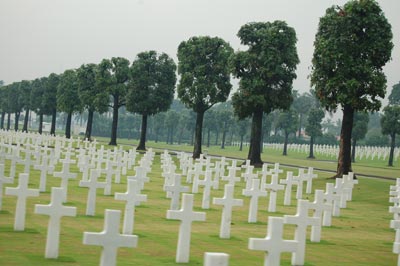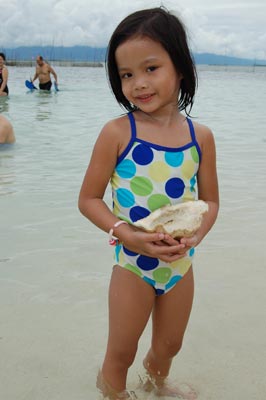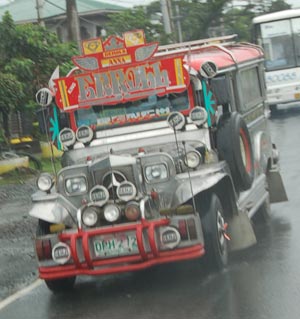The Philippines
by Roger Canfield, Contributing Editor
Before my late October ’07 trip to the Philippines, I was aware that the Philippines and America share certain historical commonalities, including Christianity, colonialism, war, independence and democracy. While, on my trip, I found friendly people and fine food, the country also has its share of poverty-stricken areas.
First impressions
At the Manila airport, we were warmly greeted with leis and a “Mabuhay,” a Philippine welcoming with many meanings, like “Aloha,” but generally meaning “Live well.”
Rajah Tours (based in Manila and with a U.S. office at 47 Kearney St., Ste. 600, San Francisco, CA 94108; 415/397-0303, www.rajahtours philippines.com) transported us to the 5-star Hyatt Hotel & Casino (1588 Pedro Gil cor. M.H. Del Pilar, Malate, Manila; phone 632 245 1234, fax 632 247 1234, http://manila.casino.hyatt.com). Rooms, starting at $220, were spacious, well lit, comfortable and air-conditioned, with intermittent water pressure. The cornucopian breakfast buffet cost an additional $20.
In the rainy weather, our tour guide drove us around to catch only glimpses of the Intramuros, what remains of the walls, moats and drawbridges of the fortified old Spanish city built in the 16th century and since devastated by fires, earthquakes and World War II.
Lunch at the Bistro Remedios (1911 M. Adriatico St., Remedios Circle, Malate, Manila; phone 632 523 9153) was the first of many excellent multiple-course meals ($36). Fish, squid, pork and beef all were well presented and well seasoned.
We skipped Glorietta and Greenbelt in Makati, the upscale commercial center that has goods you can get back home but that few Filipinos can afford. Dinner at the Abe Restaurant (G/F Serendra piazza, McKinley Parkway Road, Bonifacio Global City, Taguig, Manila; phone 856 0526) was another excellent multicourse meal ($16).
Manila’s military sites
We spent our next morning at the Manila American Cemetery & Memorial. This beautifully landscaped memorial magnificently honors the American and, symbolically, some of the 147,000 military and civilian Filipino war dead of WWII.
Larger than the Normandy memorial in France, it has the largest number of graves of WWII Americans in a single place, 17,206, including those of 570 Filipino nationals who died serving the U.S. Armed Forces. Well-trimmed vibrantly green grass and stately, gnarled tropical trees accent and shade milk-white marble crosses etched with the names of the fallen.
Two large semicircles contain 25 etched concrete maps of WWII campaigns, and tall limestone pillars list every name of the 36,285 missing. The cemetery is open daily, 9-5, except Dec. 25 and Jan. 1.
On day three we traveled two hours toward Laguna on our way to Villa Escudero. Since 1872, Villa Escudero (phone 521 0830, www.villaescudero.com) has been the estate of the Escudero family. The family is proud of its museum of eclectic collections of ancient to modern artifacts, but I found the artifacts to be dusty and poorly identified.
Next we ferried across Manila Bay to the sea-breeze-cooled island of Corregidor, an Allied fortress during WWII. Sun Cruises (phone 632 831 8140, www.corregidorphilippines.com) offers day trips from the pier every morning (PHP1,999, or $48, including lunch). Overnight packages are also available, at the Corregidor Inn, starting at 2,880 pesos ($69) and including ferry transfers, entrance fees, lunch and a guided island tour.
Sun Cruises gave an excellent video briefing of historic Corregidor, the first line of defense of Manila Bay, once marked with bonfires for the friendlies and massive cannons for enemies.
I liked the Spanish lighthouse, but the highlight was Malinta Tunnel (entry, 150 pesos), a tunnel complex that also served as headquarters for Gen. Douglas MacArthur just prior to the fall of Bataan. Informative audiovisual presentations brought their history to life.
Back in Manila, we had still another superb dinner — filet mignon, scalloped potatoes and red wine — at the Hyatt’s Fireplace.
Palawan Island
The next day we caught a quick hour flight, after a lethargic security check, west to Puerto Princesa on Palawan Island. The Philippine Airlines flight cost $813; a cheaper alternative is a $50-$55 ferry ride.
In Puerto Princesa, the Legend Hotel (Malvar Street, Puerto Princesa City, Philippines 5300; phone 048 434 4270, www.legendpalawan-puertoprincesa.com) charged only $54-$62 a night — with cold water, the air-conditioning turned off and what I felt was a terrible breakfast buffet.
Our excellent guide in this area was Bing Badajos Era (Rizal Ave. Ext. Bgy. Bancad-Bancao, Puerto Princesa 5300, Palawan, Philippines; phone 0919 292 5829 or 0920 906 9256, e-mail elmundo
tours@yahoo.com). We stopped at the Butterfly Garden at the Palawan Lepidoptera Farm at Barangay Tiniguiban (phone/fax +63 48 433 5795, e-mail janp@ mozcom.com), a greenhouse filled with brown, golden, black and white butterflies hidden among yellow- and raspberry-colored flowers.
The Crocodile Farm (National Road, Barangay Irawa, Puerto Princesa, Palawan) actively breeds endangered crocodiles. One may hold a baby croc, for a tip. Seeing adult crocs savage each other in a feeding frenzy over freshly slaughtered chickens, I was happy my precious baby croc had its jaws rubber-banded shut.
The farm is open during the week from 1:30 to 5 and on Saturdays 9-12 and 1-5, and feedings are on Monday and Tuesday afternoons. Admission is 10 pesos.
We also visited the wall-less Iwahig Penal Colony, where the primitive handicrafts offered were not worth the long drive, I felt.
Lunch at the Badjao Seafront Restaurant (Abueg Road; phone 048 433 3501, www.badjaoinn.com) was in a large tropical hut hanging over the seashore. For a little over $10, we had garlic shrimp, nicely spiced squid, and watercress and seaweed in vinegar plus cracklings with pork knuckles.
Dinner at Ka Lui (369 Rizal Ave.; phone 63 040 433 2580) was all seafood and was magnificent.
River ride
On day six we drove two hours north across Palawan, over a road alternately rocky and muddy, through rainforests. Looking across Ulugan Bay, I was told that this was where warring tribes tossed the heads of their enemies off high cliffs into the bay as late as the 1950s. Now, we were told, only ecological adventures are offered here.
At Babang we took a short outrigger boat ride to the St. Paul Underground River, where a canoe boatman rowed us on the gently flowing river into the darkness of a cave to see cathedral-like ceilings. A torchlight powered by a car battery directed light onto stalactite and stalagmite formations, some of which appeared not unlike images of the Madonna and Christ.
Outside, on a wooden pathway, we spied a bayawak (monitor lizard) and shy macaque monkeys.
After our bumpy return, our evening meal in the Nido Club Restaurant at the Legend Hotel was excellent. It was hard to believe it came out of the same kitchen as our breakfast.
Island relaxation
The next day, from Santa Lourdes wharf we caught a boat to go island hopping in the cool and refreshing breezes of Honda Bay. A grand drumroll greeted us at the luxurious Dos Palmas Island Resort & Spa (phone + 6348 434 3118, www.dos palmas.com.ph). I found the resort to have intermittent hot water and expensive drinks, but it was equipped for all scuba diving, snorkeling, kayaking and fishing needs. (Room rates are $218-$268, including meals.)
We sailed out to see coral reefs and touch cool waters teeming with fish surrounding beaches of white sand. Pandan Island is a good scuba site, with restrooms and shade.
Most of one island appeared and disappeared as the tides decided, and we drank from coconuts cut for our lunch.
Taking our boat back to Puerto Princesa for our flight to Manila, we bid a sad farewell to our fantasy islands in paradise.
Our final lunch was at Casa Armas’ Tapas Bar y Restaurante (573 J. Nakpil St., Malate, Manila; phone 523 0189 or 536 1839). We had lechon de leche, suckling pig spit-roasted until the skin crackled. Hot, crunchy and peanutty, it brought back memories of the smell, flavor and texture of freshly prepared pork on my grandparents’ Indiana farm.
A few disappointments
Our tour contained too few of Manila’s many Christian churches and too little of the nightlife, like the fine popular music we got a sample of at two of the restaurants we visited.
Walking the streets of Manila and Puerto Princesa, I experienced the good humor of the locals. Even the dogs appeared happy.
However, I felt Rajah Tours missed an opportunity to provide commentary on the long rides.
Philippine Airlines is no longer bankrupt and has greatly improved its previously poor service. Business class on PAL compared favorably with that of every other airline I’ve used over the last decade. Yes, PAL lost one of my bags; maybe my luggage wanted to stay.
The business-class lounges in Los Angeles and Manila were welcome respites from airport hell in L.A. and the sweltering heat of Manila. PAL food on board was extraordinarily tasty and graciously served.
The 343 substitute Airbus, while clean and quiet, with friendly staff, had seats inadequate for sleeping on the 12 hours to Guam plus another three to Manila. However, the Boeing 744 return flight in business class had sufficient elbowroom, tilt and movement to allow sound, unbroken sleep on the jet-stream-assisted 12-hour return flight.
Overall, PAL provided a nice beginning and end to my sojourn in the Philippines.
Roger Canfield’s trip was sponsored by the Philippine Department of Tourism (3660 Wilshire Blvd., Ste. 216, Los Angeles, CA 90010; 213/487-4525, www.experience philippines.ph) and Philippine Airlines (800/435-9725, www.philippine airlines.com).





